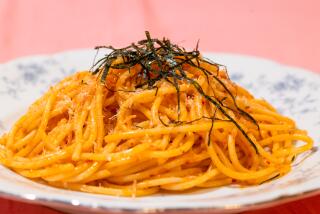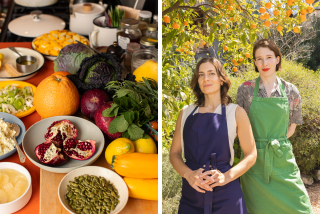The Backyard Gourmet
- Share via
Working chefs are not the sort of people you expect to be gardeners. It’s true that as a group they are the most avid consumers of fresh, seasonal food. Many of their restaurants use produce grown in small home gardens, and some of their restaurants even have gardens on the premises--usually tended by somebody else.
Here’s the problem: Chefs are too busy to do the regular maintenance needed to keep a garden productive year-round. Or are they?
Behind her ‘20s-era L.A. duplex, in a narrow space that once held a clothesline and trash incinerator, Evan Kleiman, chef-owner of Melrose Avenue’s Angeli Caffe, has carved a small organic garden. And there’s almost always something ready to eat there.
It’s not that Kleiman works fewer hours than her fellow chefs. In fact, she says her
gardening came about, in part, because she was too tired to go to the grocery store after work.
“The thing is, I hate shopping for dinner,” she says. “Some chefs ‘shop’ at their restaurants, but I never get it together enough to bring stuff home. And as tired as I am after work, I don’t want to come home to an individually proportioned microwave dinner.”
Kleiman will instead gather a few herbs or vegetables from her garden and make a meal using the staples she has on hand. Open her refrigerator and you’ll find it practically empty except for a good-sized hunk of Parmesan, which, along with garlic and onions, she says she is never without.
“I find it relaxing to putter around in the kitchen, sauteing, stirring--cooking something I’ve picked from the garden without the pressure of cooking for service. You can make such flavorful food, great soups or stews, with very little if you’re not afraid to cook. And when you hit on something wonderful, it’s the best feeling. It’s a small moment of sanity.”
The act of gardening itself is therapeutic for Kleiman as well.
“Gardening is a way for me to let off steam,” she says. “I don’t think anything in life is more calming than watering.” She waters at night or first thing in the morning before she leaves for work. On her day off, she’ll tend the soil, spreading compost and hay, or she’ll put in new plantings that she’s raised from seed in her kitchen “greenhouse” (she gets a lot of light through her windows).
“Once I got the garden going and food started growing,” Kleiman says, “I realized that gardening is the path of least resistance to incorporate fresh food into your life. You walk outside and say, ‘Oh, that looks like it’s ready to pick; there’s dinner.’ Cooking becomes more ingredient-based rather than recipe-based, which I really like and which chefs can do all the time at our restaurants because we have these closets full of food, so to speak.”
Other benefits? “With the garden,” Kleiman says, “I don’t have cilantro rotting in my refrigerator anymore. I know other people are like me; they go to the farmers market and buy all these beautiful lettuces and then they don’t use them, so they throw them away.”
These days, Kleiman picks her cilantro fresh from the yard. And despite her years of cooking experience and exposure to the city’s best ingredients, gardening has introduced Kleiman to new ingredients.
“I never ate a kohlrabi or cooked a kohlrabi until I grew it,” she says. “Here’s this strange-looking thing that looks like a mutant turnip and it’s delicious. I may not have room for cabbage in my garden, but one little kohlrabi will flavor a whole soup or stew as well as a cabbage.”
Kleiman especially likes growing greens and has even begun experimenting with Asian greens, another group of ingredients she rarely cooked with before. “Tat soi is so easy to grow,” she says. “It takes up a small amount of space and each little plant is a perfect individual serving of greens. Bok choy is like that too. It matures really quickly. You don’t have to wait a long time before you get something wonderful to eat.”
And that’s one of the true joys of having a vegetable garden: There’s always something wonderful to eat.
EGGPLANT RAVIOLI (Ravioli di Melanzane)
EGGPLANT FILLING
2 small or 1 large eggplant
1 pound ricotta
Large handful freshly grated Parmesan cheese
1/2 cup toasted and chopped walnuts
Salt
Freshly ground black pepper
PASTA
2 egg whites
Fresh Pasta Dough (see separate recipe) or 75 to 80 won ton wrappers
ASSEMBLY
Salt
Tomato-Basil Sauce (see separate recipe)
Freshly grated Parmesan cheese
1/4 cup toasted and chopped walnuts
If you are not going to cook the ravioli immediately, lay a kitchen towel over them and place the baking sheet in the refrigerator. They can be left in the refrigerator up to 3 hours. Alternatively, they can be frozen uncovered on the baking sheet, then stored in a freezer bag until needed.
FILLING
Pierce eggplant all over with fork. Place in pie pan or baking sheet with lip and bake at 400 degrees until eggplant is completely collapsed and blackened in places, about 1 hour.
Meanwhile, place ricotta, Parmesan cheese, walnuts and salt and pepper to taste in mixing bowl and stir until well mixed.
Remove eggplant from oven, slice in half and set aside until cool enough to handle. Scrape all flesh from skin and transfer flesh to colander or sieve to drain briefly. Break up drained eggplant with your hands and stir vigorously into ricotta mixture. Set aside.
PASTA
Lightly beat egg whites in small bowl.
If using Fresh Pasta Dough, roll out on thinnest or next to thinnest setting of pasta machine, then cut into sheets of manageable length, about 16 inches long. Do not roll out too many sheets at 1 time or dough will dry out and become difficult to handle.
Place 1 generous teaspoon Eggplant Filling every inch in row across center of 1 pasta sheet. Lightly brush egg white along side and bottom borders of dough, also between each dollop of filling. Carefully fold sheet in half toward you, matching horizontal edges of dough. Gently press dough down between each dollop of filling. Cut ravioli apart. Let ravioli sit on floured surface to dry at least 5 minutes before cooking.
If using won ton wrappers, lay out 6 wrappers in row on working surface. Place 1 teaspoon filling in center of each won ton square. Dip pastry brush in egg white and dampen 2 adjacent edges of each square. Enclose filling by folding 1 corner to opposite corner, creating triangle shape. Press edges down to seal. Continue with remaining pasta until filling is used up. As ravioli are made, lay them on baking sheet lightly dusted with flour. Cover with kitchen towel and set aside until ready to cook.
ASSEMBLY
Bring large pot of salted water to boil. Add ravioli. When ravioli float to top, allow them to cook 1 minute. Carefully drain in colander and transfer to serving platter. Top with hot Tomato-Basil Sauce, dust with Parmesan cheese and sprinkle with toasted walnuts.
6 servings. Each serving:
762 calories; 569 mg sodium; 262 mg cholesterol; 38 grams fat; 71 grams carbohydrates; 35 grams protein; 2.23 grams fiber.
FRESH PASTA DOUGH (Pasta all’ Uovo)
4 cups unbleached all-purpose flour
6 extra-large eggs
To make in food processor, put 1/2 of flour in processor fitted with steel blade. Beat 3 eggs separately and add gradually to processor, pulsing until eggs and flour come together. (Do not add eggs all at once. Depending on humidity, you may need less than amount called for.) Repeat with remaining flour and eggs.
If using mixer, use all of flour and all of eggs, beating eggs separately before adding to flour. Can also be made by hand by mounding flour on work surface, forming well in middle for eggs and gradually working eggs into flour with hands or fork, then kneading until dough forms.
Turn mixture onto work surface (if made in processor or mixer) and knead together firmly. Cover with kitchen towel and let rest at least 15 minutes (or wrap in plastic and refrigerate up to 1 day) before kneading and rolling out.
Unwrap ball of dough and cut into quarters. Rewrap remaining dough. Flatten slice with heel of your hand. If dough feels tacky, lightly coat each side with flour.
Dough can be formed into various shapes using pasta machine. For ravioli, see Eggplant Ravioli recipe.
Enough for 10 ravioli servings. Each serving:
212 calories; 39 mg sodium; 128 mg cholesterol; 3 grams fat; 35 grams carbohydrates; 9 grams protein; 0.14 gram fiber.
TOMATO-BASIL SAUCE
1/4 cup extra-virgin olive oil, plus extra for drizzling
2 to 3 cloves garlic, minced
Pinch red pepper flakes
12 Roma tomatoes or 6 large tomatoes, quartered
5 to 6 large fresh basil leaves, whole or roughly chopped
Salt
This is a wonderful sauce not only for the Eggplant Ravioli but for just about any kind of pasta.
Heat oil in large skillet over moderate heat. Add garlic and red pepper flakes. As soon as garlic gives off aroma and becomes opaque, add tomatoes. Cook over high heat until tomatoes begin to thicken, about 10 minutes. Stir and break up tomato pulp with wooden spoon. Add basil and salt to taste. Remove sauce from heat and put through a food mill using medium disk. This will remove skins and create smooth texture. Alternatively, process in a food processor or blender and strain.
Sauce for 10 pasta servings. Each serving:
64 calories; 36 mg sodium; 0 cholesterol; 6 grams fat; 4 grams carbohydrates; 1 gram protein; 0.49 gram fiber.
CARAMELIZED PEARS WITH MASCARPONE (Pere al Mascarpone)
9 tablespoons butter
3/4 cup sugar
6 ripe Bosc or Comice pears, peeled, cored and cut into eighths
1/4 cup dessert wine, such as TK
1 cup mascarpone
Heat butter in saute pan over medium heat until it is bubbling. Add sugar and cook until it begins to color. Add pears and cook until they are tender, 10 to 15 minutes (cooking time may vary according to ripeness of pears). Remove pears from pan to serving platter, raise heat to high and continue to caramelize sugar mixture. Add wine to pan and cook until caramel sauce forms, 2 to 3 minutes.
Serve pears warm or at room temperature topped with caramel sauce and large dollop of mascarpone.
6 servings. Each serving:
416 calories; 44 mg sodium; 62 mg cholesterol; 23 grams fat; 50 grams carbohydrates; 2 grams protein; 2.32 grams fiber.
BRUSCHETTA WITH FRESH SHELL BEAN PUREE AND MIXED MUSTARD GREENS (Bruschetta ‘Ncapriata)
1 cup dried flageolet, Great Northern or cannellini beans
1/2 onion
Water
Salt
Extra-virgin olive oil
5 cloves garlic, plus 1 to 2 optional cloves garlic
2 large bunches or 4 small bunches greens (such as spinach, mustard greens, chard, tat soi)
2 anchovy filets
Salt
12 slices bread
Soak beans overnight in water. Drain. Place beans and onion in small saucepan. Add water to cover by 2 inches, bring to rolling boil and boil 5 minutes, then reduce heat and simmer until beans are very tender, about 40 minutes, adding just enough water if necessary to keep beans covered. Add salt to taste during last few minutes of cooking.
When beans are very tender, remove onion and drain off nearly all water, leaving just enough for mashing beans into fluffy puree. Mash beans with potato masher, adding olive oil to taste. Press 1 to 2 cloves optional garlic and mix into beans.
Wash and dry greens and remove fibrous stems or ribs. Stack leaves, roll up and slice across to make thin strips. Mince 2 cloves garlic. Heat 2 tablespoons oil in skillet over medium heat. Add minced garlic, anchovies, greens and salt to taste. Cover pan and cook until greens wilt and are tender. Remove pan from heat. Drain off excess liquid.
Grill or lightly toast bread. Rub each slice with remaining garlic cloves and drizzle with olive oil.
To serve, put toast, greens and bean puree on serving platter. Let each guest spoon beans onto toast and top with bit of greens.
6 servings Each serving:
363 calories; 588 mg sodium; 3 mg cholesterol; 7 grams fat; 60 grams carbohydrates; 15 grams protein; 2.60 grams fiber.
OLIVE SALAD (Insalata d’Ulivi)
20 cracked green olives, pitted and coarsely chopped
40 Kalamata olives, pitted and coarsely chopped
2 tender celery stalks from heart of bunch, thinly sliced
1/2 cup coarsely chopped Italian parsley
2 cloves garlic, minced
2 bunches purslane (verdolaga), washed and chopped, thick stems discarded
1/4 cup extra-virgin olive oil, or to taste
1 tablespoon red wine vinegar, or to taste
Freshly ground black pepper
Combine green and Kalamata olives, celery stalks, parsley, garlic, purslane, oil, vinegar and pepper to taste in mixing bowl. Toss to mix. Cover and refrigerate at least 2 hours, up to 24 hours, to blend flavors.
6 servings Each serving:
163 calories; 656 mg sodium; 0 cholesterol; 17 grams fat; 4 grams carbohydrates; 2 grams protein; 1.30 grams fiber.
More to Read
Eat your way across L.A.
Get our weekly Tasting Notes newsletter for reviews, news and more.
You may occasionally receive promotional content from the Los Angeles Times.











